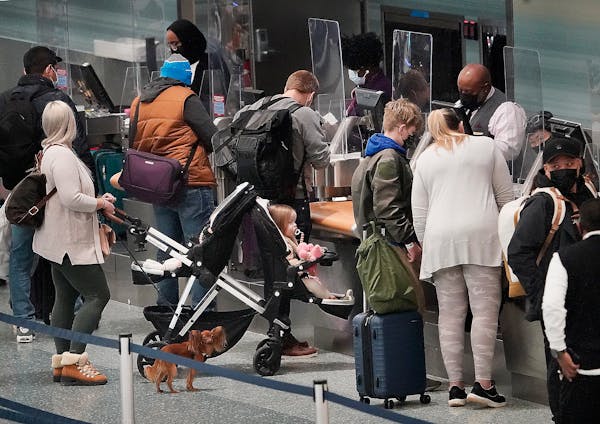A prisoner advocacy group called on Minnesota corrections officials Wednesday to reinstate an early release policy for inmates with medical conditions that make them vulnerable to COVID-19 complications.
At the beginning of the pandemic in 2020, the state Department of Corrections said it would implement the program for those at "grave risk" of COVID-19, including those who did not previously qualify for the agency's conditional medical release policy.
The program was discontinued after COVID-19 vaccines were approved and introduced to the prison population. Of nearly 2,300 prisoners who applied for release, only 158 qualified.
The Incarcerated Workers Organizing Committee, a prison reform group that includes people inside prisons and in communities, urged Corrections Commissioner Paul Schnell at a news conference to use his existing authority to grant prisoners medical leaves as well as work releases.
"We are trying to have a less crowded system to inhibit the spread of a contagious disease," group member Reece Graham said. "Then it only makes sense to enact the policies that we already have.
"There are thousands of people who are low risk to the public that can be placed into job training programs. We are not talking about creating a new law. What we are talking about are the powers that the commissioner has already and has not seen fit to use."
Schnell said advocates and families overestimate his powers when it comes to early releases.
"We have to comport with the law, and I think what people would like is if as long as they had a medical condition they could be released and that is not what the law required," he said.
Schnell said several requirements must be met, including stable housing, income and health care arrangements.
Of those who applied for medical leave, about 1,300 did not have a qualifying condition and about 600 were denied for community safety concerns, according to the Corrections Department.
"Ultimately, we brought the program to a close when vaccines became readily available," Schnell said. "The focus is a test and vaccine strategy."
The COVID-19 omicron variant has swept through much of the state's prison system with 2,562 prisoners recently testing positive — about 35% of the inmate population. That includes nearly 1,100 infections at the Faribault prison and 622 at Stillwater.
Across all the prisons, 79% of inmates have been fully vaccinated and 33% have received booster shots. Among prison workers, 70.6% have completed a vaccine series.
Prisoner advocates say inadequate masks, poor hygiene and crowded conditions set the stage for ongoing transmission of the virus, which has become worse as new, more infectious strains emerged.
"We have some of our most marginalized communities, folks with really profound chronic health conditions that increase their risk for severe COVID infection," said Rebecca Shlafer, a University of Minnesota professor who works with prison advocates. "You layer that on with a correctional environment which makes the mitigation of COVID exceptionally challenging."
Schnell said the Corrections Department expected omicron to cause a spike in new cases and officials will focus on vaccinating more people inside the prison walls. Prisoners are not required to get the shot, while employees are subject to a vaccination or test requirement.
"If we really want to reduce risk, we are going to have to focus on maximizing vaccination rates," he said. "Because we have 80% vaccination rates among our population, we don't see severe illness and hospitalizations as much as we have in previous instances."
Dan Shulman of the ACLU of Minnesota, which has twice sued the Corrections Department over its COVID-19 policies, said he still receives reports about lapses in pandemic safety measures, such as the enforcement of masking requirements.
"Getting COVID was not part of the sentence that any of these people was subjected to and shouldn't be," Shulman said. "They are still not doing what they should be doing in the prisons. The rate of vaccination among the guards and among the correctional officers is disgracefully low."
A Corrections Department spokesman acknowledged lapses in some safety measures and discipline is possible for staff and inmates who don't comply with masking requirements.
Although the COVID-19 medical release program has ended, a work release program remains in place. Corrections officials said in April 2020 that inmates within 90 days of release would qualify if they met program requirements.
Since the pandemic began, 288 of the 372 inmates who have applied have been approved.
But the Incarcerated Workers Organizing Committee said the department's own data indicate that up to 1,600 could be released.
Schnell said prisoners' risk to public safety is one consideration for work release, but they also must obtain approved housing and have access to a landline or the internet for ongoing monitoring.
David Boehnke of the advocacy organization said the Corrections Department could do more to help prisoners successfully transition to work release.
"There are so many people and so many organizations that care about people in prison. They need to partner with the community to find solutions," he said. "Instead of talking at us and telling us what they won't do, they should be working with us to create solutions."

Fired Mpls. teacher accuses management of 'cancerous rot'

Jill Biden rallies women, teachers for the Biden-Harris ticket in Bloomington speeches
Neighbors, city officials at odds over Rochester lake dam

Souhan: This is KAT's chance to prove Flip Saunders was right

